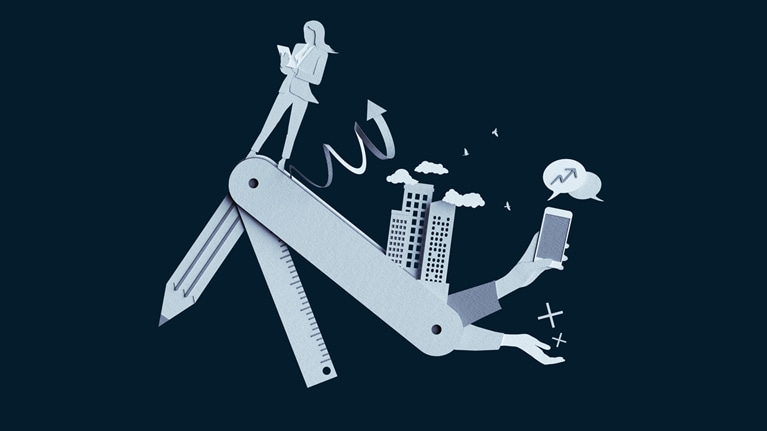Business leaders around the world are increasingly turning to the ecosystem business model to achieve top-line goals such as growing core businesses, generating revenues from new products and services, and creating new value pools. The appeal of ecosystems—interconnected sets of services through which users can fulfill a variety of cross-sectoral needs in one integrated experience—has only grown as the global pandemic accelerated consumers’ migration to digital. Consumers are embracing this shift, with 71 percent saying they’re ready for integrated ecosystems.
Indeed, by 2030 the integrated network economy could account for 25 percent of the total economy—up from 1 to 2 percent today—with global revenues of $70 trillion (Exhibit 1). A fringe topic just a few years ago, the ecosystem model is increasingly important and relevant. Customer demand is clear and measurable. Many companies of all sizes and industries have started developing cross-sector ecosystem offerings, and the financial markets have acknowledged the power of ecosystem plays.

However, shifting to—and monetizing—an ecosystem strategy is not easy. Recent McKinsey research reveals that only 50 percent of companies report even limited early success with their ecosystem plays; only roughly 10 percent are generating significant revenue. Creating interconnected services that fulfill user needs across a variety of sectors is a complex endeavor that demands not just a cohesive strategy but also a design-led approach.
This article describes the three phases of ecosystem adoption—define the strategy, design the ecosystem, and build the ecosystem—and articulates the benefits of design-led thinking during each phase. It includes an example of a grocery retailer that used an ecosystem model to expand into additional consumer sectors, thus staving off competitive threats and creating new sources of value.
A design-led approach to ecosystem planning
The importance of design in business decision making, especially for achieving large, ambitious goals, is well established. Organizations that use design as a strategic tool to develop intuitive products and experiences that meet customer needs have leapfrogged their peers. With design embedded into their culture, they can continually innovate at scale.
Pursuing an ecosystem strategy is a long-term initiative comprising three phases: define the ecosystem strategy, design the ecosystem, and build the ecosystem. Each phase benefits from design disciplines such as design research, interaction design, user-interface design, and, perhaps most notably, service design. Indeed, it is only through thoughtful, innovative service design that a company can ensure its ecosystem transcends each industry sector to become a truly connected business from front to back.
Define the ecosystem strategy
Many business leaders don’t know how to select the ecosystems, or how to identify those opportunities with the highest value. Shaping the ecosystem strategy requires focused, design-led work in three areas:
Identify the most relevant trends. A mix of social, economic, and technological trends influence how consumers behave and what they need and want from their products and services. Forecasting is a powerful tool for understanding where these trends are headed. Designers can use trend forecasts to develop scenarios that envision how consumers across sectors and markets are likely to respond to changes, and how the company could expand its products and services beyond the core to better connect with consumers and serve them. Because they tend to be adept at divergent and convergent thinking, designers offer distinct value in these exercises and can help find innovative, expansive solutions.
Plan a desirable ecosystem and identify the value pools. An ecosystem strategy should focus on high-growth areas that align with the organization’s business ambitions and capabilities. Design-research methods such as ethnographic studies, coupled with quantitative research—for instance, market sizing and value-pool analysis—can help the company home in on the use cases, customer segments, and new products and services with the highest value, and assess whether it can address them.
Tightly define the core value proposition. When shifting to ecosystems, many organizations fail to leverage their distinctive advantages to crystallize the specific customer-value proposition. The most distinctive propositions sit at the convergence of customer data, market trends, customer experience, business ambition, and vision. A series of design-facilitated co-creation sessions that put all of these considerations on the table can be helpful in generating a list of potential propositions. Notably, these propositions should not be limited to a channel or market; rather, they should reflect consumer behavior trends that cut across sectors. The next step is to evaluate each potential value proposition on the basis of current business capabilities, customer needs, and growth potential. From there, business leaders can choose the core value proposition for their ecosystems, including estimates of their value.
Would you like to learn more about McKinsey Design?
Design the ecosystem
The new ecosystem design will need to start with the customer’s view and deliver on the agreed-upon value proposition and experience. To achieve this, organizations can consider three domains: consumers, sectors and partners, and products and services. Design has a central role to play in each.
Consumers. Having placed bets on how consumer behavior will shift in the future, the company can then design its ecosystem. Mapping journeys is a bedrock design activity that helps organizations envision the experience from the vantage of consumers. Each journey is designed as an interconnected end-to-end experience.
Designing the service blueprint dovetails with journey mapping, which displays step by step within and across channels how the ecosystem will operate from the perspective of the consumer, business operations, and employees. It also describes the shifts the company will need to make—for example, investing in new digital capabilities—and the partnerships it will need to forge to support the ecosystem. The company will also need to define the financial shifts required to support its transition to ecosystems. Designing a successful ecosystem takes discipline and restraint. An ecosystem offering that cuts across too many segments without a clear value proposition can appear generic and watered down. Trying to win everything is impossible; to truly move the needle, focus on a smaller segment first.
Sectors and partners. An ecosystem is cross-sectoral by definition, enabling consumers to navigate from one type of service, such as buying groceries, to a distinctly different one, such as buying insurance (see sidebar, “Creating value across all sectors”). It falls to designers to identify consumers’ needs and create a journey that they can easily navigate. A well-designed, seamless experience masks the complexity that went into creating it and reflects the creativity and innovative mindset of the designers.
Each core journey will address how these cross-sectoral experiences will unfold on the front and back end. In the case of the grocery retailer, the journey design reflects how a customer seamlessly buys groceries, discovers an insurance offering, gets prequalified, and applies for insurance. But designing for the overall experience is equally important. For example, a holistic customer-engagement and loyalty program may enable customers to earn points that can be aggregated and used within any sector included in the ecosystem. Finally, these cross-sectoral propositions will likely include a complex set of partner relationships, and designers can help to visualize how those relationships develop.
Products and services. Having laid the groundwork—with research, customer interviews, journey mapping, blueprints, and so on—the company can turn its attention to its connected products or services, whether they are physical, digital, or a combination of the two. This connectedness, which is fundamental to the ecosystem model, could be designed as a “super app,” a digital platform, or a suite of offerings.
Before building out the offering, the company should rigorously test the concept with target customers—and with each business leader who has ownership in the proposition—to crystallize the end-to-end journey and the partner network, along with the capabilities, back-end architecture, and operating model needed to support it internally. Given the scale of the undertaking, a team of designers, product owners, and operational experts will then develop a detailed road map for building out the offering, allowing the organization to enter the market quickly and capture the opportunity before others.
Build the ecosystem
To achieve success with ecosystems, it is crucial to create a flexible and agile operating model that is capable of not only continually rolling out new solutions but also managing the entire portfolio of value propositions by addressing failures, branching out into new areas, and pivoting the focus along the way. This requires a number of cultural shifts.
One cultural shift may entail including design leaders in the transformation process from the outset. Isolating designers in a design-only team naturally creates silos and barriers to creativity and innovation. Bringing designers together with business strategists, developers, and product owners to collectively solve problems and shape solutions leads to superior results.
Additionally, a new governance model can help ensure that design is truly integrated into the ecosystem operating model. It can clarify design roles, methods, and activities from strategy to ongoing delivery, outlining expected outcomes at each stage. It can also detail the consequences of sidestepping design by, for example, failing to conduct customer research before choosing a value proposition, mapping journeys that are not interconnected, or preparing blueprints that don’t fully reflect back-end activities (Exhibit 2). Design role models and organization leaders need to continually reinforce the governance model and promote the value of a design-led ecosystem with ongoing training and education.

As we slowly rebound from the pandemic, businesses will likely continue to pursue growth and innovation with a shift to ecosystems, designing new products and services and omnichannel experiences that engage customers in novel ways. As more of these offerings go digital, companies can only achieve true differentiation by embedding customer centricity, design principles, and a spirit of experimentation across their organizations. The bar for ecosystem success will only get higher from here, challenging participants to marshal all their resources to come out on top.


